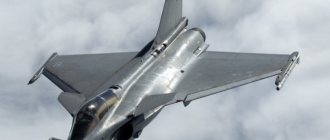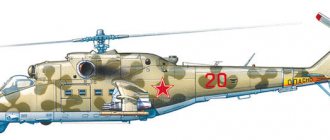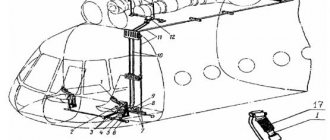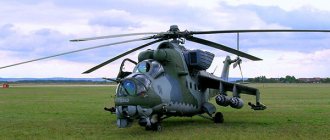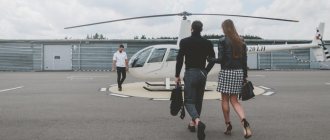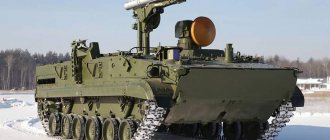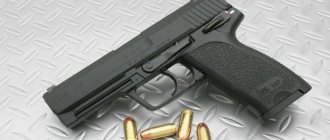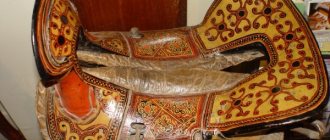HELICOPTER, rotary-wing aircraft, also called rotorcraft, is an aircraft in which the lifting force is generated by rotating propellers.
Although rotary-wing aircraft were only flown in the 20th century, the concept of the rotorcraft itself has much earlier origins. In the manuscript of Leonardo da Vinci (1452–1519) there is a drawing of a machine with a propeller on a vertical axis, driven by the muscular power of a person flying on it. This is undoubtedly a prototype of a helicopter. Also on topic:
AEROSPACE AIRCRAFT CONSTRUCTION
Currently, there are both small two-seat training helicopters and giant transport rotorcraft capable of lifting more than 22 tons of cargo into the air and transporting, for example, tracked vehicles. Helicopters are highly maneuverable and versatile aircraft designed to perform a variety of functions and do not require large and level areas for takeoff and landing.
Airplanes can fly faster than helicopters, but only in one direction. Helicopters rarely reach speeds above 320 km/h, but can move in any direction and hover in the air if necessary.
Torque.
Due to the rotation of the propeller, a moment of force acts on the helicopter fuselage, twisting it in the opposite direction. There are several ways to compensate for this torque, and helicopter designs vary accordingly.
The most common design is with a large main rotor mounted above the fuselage to provide lift and horizontal movement, and a small tail rotor that rotates vertically like an airplane propeller and is used for control. The tail rotor creates a thrust force, the moment of which is opposite to the torque generated by the main rotor, and prevents the rotation of the fuselage.
In a twin-rotor configuration, the helicopter has two main rotors rotating in a horizontal plane. The propellers are installed at opposite ends of the aircraft and rotate in opposite directions, mutually compensating the moments. In twin-propeller designs, one propeller is located in the front part of the fuselage, and the second in the tail; This pattern is called longitudinal. On some rotorcraft, these two rotors are located at the ends of the transverse outrigger trusses (transverse design); According to this scheme, aircraft with rotary propellers are made (see below).
Finally, there are helicopters with rotors mounted one above the other on the same axis and rotating in opposite directions. This scheme is called coaxial. The coaxial design is one of the first concepts of rotorcraft, but it found practical implementation only in the Soviet Union (helicopters of N.I. Kamov, who began designing them in the early 1920s).
Although the helicopter design with main and tail rotors turned out to be the most suitable in many respects, there was a desire to remove the tail rotor, since its operation consumes part of the engine power, and the blades can be dangerous. (USA) has developed an aircraft in which the torque is damped using an air jet blown from the tail of the helicopter. By adjusting the magnitude and direction of the jet's reactive force, the pilot creates a compensating torque.
MI-24 - the most versatile
This heavily armed Rostov comrade, nicknamed “Crocodile,” became a real nightmare for the opponents of the Soviets in the East: the Mujahideen fled in horror at the mere sound of “Shaitan-Arba.” The “flying infantry fighting vehicle” could land troops and independently provide them with fire cover. From a technical point of view, the Mi-24 is a hybrid of a helicopter and an airplane, because it has wings that provide it with at least a quarter of its lift. Armored predator cold war
fought on three continents.
Flight control system.
The helicopter's flight is controlled using four controls. These are the engine control lever, the “step-throttle” lever, the control stick and the foot control pedals for the tail rotor.
The engine control lever regulates the fuel supply and therefore the engine power.
The pitch-throttle lever is used to regulate the lift force by changing the overall pitch of the main rotor blades. This lever is located to the left of the pilot's seat. By lifting the lever up, the pilot increases the angle of inclination (pitch) of the blades - simultaneously and equally on all blades. As the pitch angle increases, the lifting force of the propeller increases.
The control handle is used to change the direction of movement: forward, backward or sideways. It is located directly in front of the pilot. By tilting the handle in the desired direction of flight, you can tilt the axis of the rotor disk in the corresponding direction. When the axis of the disk is tilted forward, the nose of the aircraft tilts down and a forward acceleration is created. When the control stick is tilted toward itself, the pilot lifts the nose of the aircraft up and the helicopter moves backward.
Tail rotor foot control (i.e. yaw) pedals are used to change the pitch angle of the tail rotor blades, used to compensate for torque. The greater the pitch angle of the tail rotor blades, the greater its thrust and the more torque from the main rotor it can absorb.
Controlled helicopter flight is possible even when the engine is stopped. The air flow generated as the helicopter moves forward or descends maintains the rotation of the propeller. This phenomenon is called autorotation. At a relatively high flight altitude, the pilot will have enough time to choose a place for an emergency landing, fly up to it and make a soft landing. The use of this phenomenon is included in the training program for novice pilots.
Helicopters have qualities that allow them to be used in unconventional situations. For takeoff and landing, they can use any small area, including the decks of ships, roofs of buildings, forest clearings and beaches. They do not require special runways. In addition, they can carry large loads and lower them to a precisely specified location. As a result, helicopters are capable of performing a variety of specific tasks, in particular high-altitude installation work.
MI-26 is the largest
Created in 1977, the helicopter received the unkind nickname “Cow”, although “ant” would be more suitable for it, because with its take-off weight of 49,650 kg it is designed to be able to carry loads greater than its own weight
.
According to calculations, the helicopter was supposed to carry up to 80 fully equipped paratroopers. But the brave Soviet leadership did not care about the calculations and loaded up to 150 people into the car. And the most paradoxical thing: the “Cow” took off with such a full “belly”. In 1999, it was this record-breaking machine that was entrusted with transporting a 25-ton block of ice with a 23,000-year-old mammoth from Siberia
. During the liquidation of the consequences of the Chernobyl Nuclear Power Plant, these giants, overloaded with additional lead protection, on elongated external suspensions (so as not to raise radiation dust) were engaged in installation work of unimaginable complexity in the fourth block. At the end of the operation, the helicopter pilots, with tears in their eyes, escorted all their “combat friends” to burial in the Exclusion Zone.
USE OF HELICOPTERS
Helicopters were first used for military purposes during World War II for patrol and rescue work. Evacuation of casualties from the battlefield was a major mission for helicopters during the Korean War. These helicopters had piston engines, and therefore their flight speed and payload were low.
American helicopters with gas turbine engines appeared during the Vietnam War. The role of helicopters has increased significantly. Military helicopters were used for surveillance, transporting troops and equipment.
Later, helicopters began to take an active part in combat operations. Armed with rockets and rockets, the helicopter became a highly effective anti-tank weapon. Further improvement of optical instruments expanded the possibilities of using helicopters to monitor the movement of troops even at night (using infrared night vision devices). Reconnaissance helicopters and helicopters appeared to perform special missions, such as fighting terrorists.
The US Army has more than 7,000 operational helicopters. The US Navy, Marine Corps and Air Force also use helicopters.
Helicopters find universal use as a means of transport. They are used for aerial surveillance, search and rescue operations, and transport of people and cargo, especially in hard-to-reach areas.
Almost a quarter of US civilian helicopters are owned by private companies. Company utility helicopters are used primarily to transport workers to business centers, company branches and airports.
Helicopters also serve regular passengers. Many large cities have scheduled helicopters that fly between the city center and the nearest airports.
Fishermen use helicopters to locate schools of fish. Farmers use them to treat crops, and foresters use them to detect forest fires. The versatility of helicopters has contributed to their successful use in numerous completely different areas of human activity.
OTHER TYPES OF ROTORIQUES
There are rotorcraft that are not, strictly speaking, helicopters. These include a gyroplane, the autorotating propeller of which creates lift, but does not allow it to hover in the air. A gyroplane requires a runway to take off and land.
Juan de la Cierva invented the gyroplane in 1919. The first models of his aircraft were equipped with a rotor with free-flapping bamboo blades. This gyroplane did not have a tail rotor, since it did not need to compensate for torque.
Helicopters are more maneuverable than fixed-wing aircraft, but have a slower flight speed. Engineers have long dreamed of combining the advantages of these different types of aircraft.
An example of such a device is a tiltrotor (convertible aircraft). This aircraft takes off and lands like a helicopter, but it transforms into a fixed-wing aircraft when flying in the air. There are several options for the design of such convertible devices.
One design uses a rotor with spinning blades for takeoff and landing. At cruising altitude the blades stop. They can then be removed inside the fuselage or left outside, used as wings. A project was developed and a prototype of such a configuration of a convertible aircraft was tested.
The concept of a convertible aircraft was most developed in the configuration of an aircraft with rotary propellers located at the ends of the wing of this aircraft (see CONVERTIBLE AIRPLANE; MILITARY AVIATION). During takeoff and landing, the propellers rotate in a horizontal plane, like on a transverse helicopter. When cruising altitude is reached, the propeller nacelles are rotated 90° so that the propellers rotate in a vertical plane similar to the propellers of a twin-engine fixed-wing aircraft. Various variations of this arrangement have been explored. In the United States, the greatest success has been achieved in the helicopter industry, which has developed, in particular, the improved VTOL aircraft XV-15, which transitions from vertical to horizontal flight by turning the rotor nacelles.
together with Boeing Helicopter, it also developed and launched into production a VTOL aircraft with rotary rotors, capable of carrying more than 40 passengers. This multi-role military aircraft is also suitable for many civilian missions. Since such an aircraft does not require large runways to take off and land, it can be used to relieve congestion at airports. See also CONVERTIBLE AIRCRAFT.
FLYING PLATFORMS
One type of rotary-wing aircraft is flying platforms. Like helicopters and tiltrotors, they are held in hover mode by the lifting force created by the continuous downward acceleration of the surrounding air masses.
Unlike hovercraft, flying platforms are capable of rising to significant heights. A flying platform is a rotary-wing aircraft in which the size of the main rotor is small compared to the body.
The first free flight of the flying platform was carried out on February 4, 1955. The constructed helicopter platform had a diameter of 1.8 m. The rotation of the propellers was carried out by two engines.
Flying platforms have three disadvantages, all of which are due to the small size of the rotors. Firstly, due to the small size of the main rotor, in order to create the required lifting force, it is necessary to increase the jet speed. This jet causes soil erosion and raises clouds of dust. In addition, to create a high-speed jet, you need a high-power engine and a lot of fuel. Secondly, due to the small size of the main rotors, in the event of an engine failure, a high rate of descent of the platform can lead to disaster. To solve this problem, flying platforms are equipped with several separate engines. Thirdly, with such relationships between the dimensions of the rotors and the aircraft as a whole, significant aerodynamic interference arises, especially strong during horizontal flight. These interferences significantly worsen stability and controllability characteristics.
MI-8 - the most popular
Since July 1961, more than 17 thousand Mi-8 helicopters and its modifications have been produced. Because of its reliability, the machine is a welcome guest in more than 50 countries around the world, because it is able to cope with tasks in almost any conditions - from Africa to the Far North. The popularity of the Mi-8 is truly justified: unpretentious, simple, versatile
the helicopter is capable of coping with a full range of tasks.
its place in the top 10 best helicopters in the world with another personal unbroken record - climbing to a height of 8100 meters in 13 minutes.
